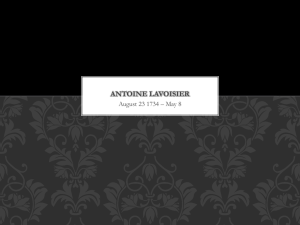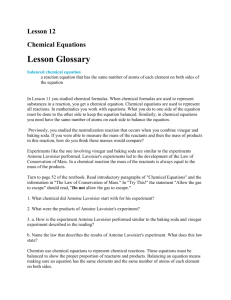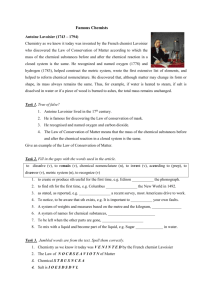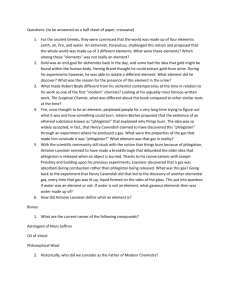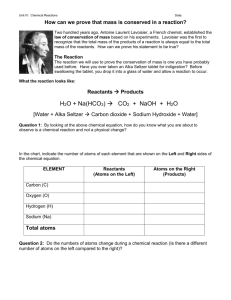Spring Break Packet –M/L
advertisement
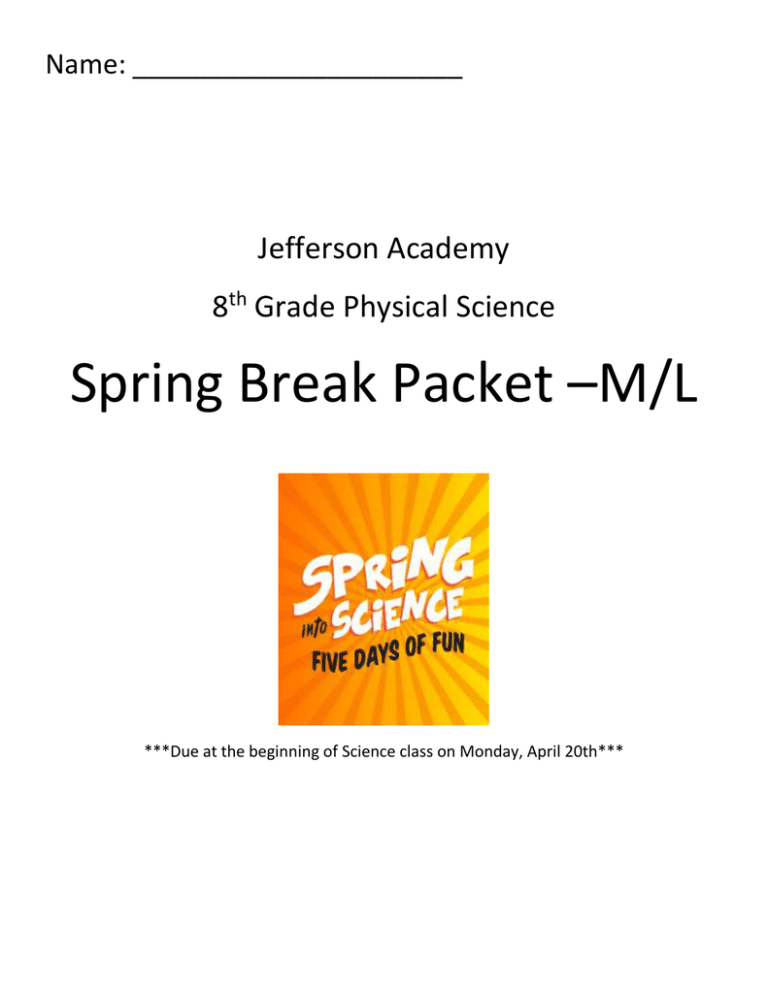
Name: ______________________ Jefferson Academy 8th Grade Physical Science Spring Break Packet –M/L ***Due at the beginning of Science class on Monday, April 20th*** Spring Break Packet Checklist o Have parent read and sign the informational letter o Complete the 2 assignments o Complete the take home test o Turn in completed packet to Ms. Hillenbrand on 4/20/15 4/20/15 Dear Jefferson Families, Your 8th grade student has been studying chemistry and matter interactions in Physical Science class. In between relaxation and Spring Break fun, all students are to extend their learning by completing the 3 assignments in this packet. Assignment 1 (pg. 5-7): 100 point classwork assignment Assignment 2 (pg. 8): 100 point classwork assignment Assignment 3 (pg. 9-15): 100 point exam These assignments are connected to the following 8th Grade Next Generation Science standards: MS-PS1-1 Develop models to describe the atomic composition of simple molecules and extended structures. MS-PS1-2 Analyze and interpret data on the properties of substances before and after the substances interact to determine if a chemical reaction has occurred. MS-PS1-5 Develop and use a model to describe how the total number of atoms does not change in a chemical reaction and thus mass is conserved. This completed packet will be turned in to me on Monday, April 20th for two classwork grades and an exam grade. Late packets will lose 10 points every day they are late. The last date students can turn in packets for credit is May 1st. After that students will receive a “0.” Please sign below to acknowledge that you read this letter and are aware of your student’s assignment. Don’t hesitate to reach out if you have any questions or concerns. Have a wonderful spring holiday! Sincerely, Ms. Trilby Hillenbrand trilby.hillenbrand@dc.gov (315)440-6159 I have read the informational letter, and I am aware of my student’s winter break assignment. Parent Signature: ____________________________________________________________ Date: _____________________ Suggested Calendar for Completion Monday 4/13 o Assignment 1-Read article and complete summary Tuesday 4/14 o Assignment 1-Re-read article and answer questions Wednesday 4/15 o Complete Assignment #2 Thursday 4/16 o Assignment 3-Complete questions 1-13 Friday 4/17 o Assignment 3-Complete questions 14-22 Monday 4/20 o Packet due to Ms. Hillenbrand Assignment 1: Biographies for Kids Antoine Lavoisier Adapted from: http://www.ducksters.com/biography/scientists/antoine_lavoisier.php Occupation: Chemist Born: August 26, 1743 in Paris, France Died: May 8, 1794 in Paris, France Best known for: Founder of modern chemistry Biography: Early Life Antoine Lavoisier was born in Paris, France on August 26, 1743. He grew up in an aristocratic and wealthy family. His father was a lawyer and his mother died when he was only five years old. Antoine discovered his love for science while attending college. However, he initially was going to follow in his father's footsteps, earning a law degree. Career Lavoisier never did practice law because he found science much more interesting. He had inherited a good deal of money when his mother died and was able to live as a nobleman, pursuing various interests. Lavoisier worked in various government positions and was elected to the Royal Academy of Science in 1764. In 1775, Lavoisier set up a laboratory in Paris where he could run experiments. His lab became a gathering place of scientists. It was in this lab where Lavoisier made many of his important discoveries in chemistry. Lavoisier considered it important to use experiments, precise measurements, and facts in science. The Law of Conservation of Mass One of the main scientific theories of Lavoisier's time was the phlogiston theory. This theory stated that fire, or combustion, was made up of an element called phlogiston. Scientists thought that when things burned they released phlogiston into the air. Lavoisier disproved the phlogiston theory. He demonstrated that there was an element called oxygen that played a major role in combustion. He also showed that the mass of products in a reaction are equal to the mass of the reactants. In other words, no mass is lost in a chemical reaction. This became known as the Law of Conservation of Mass and is one of the most important and basic laws of modern chemistry and physics. The Elements and Chemical Nomenclature Lavoisier spent a lot of time isolating elements and breaking down chemical compounds. He invented a system of naming chemical compounds that were made up of multiple elements. Much of his system is still in use today. He also named the element hydrogen. Water is a Compound During his experiments, Lavoisier discovered that water was a compound made of hydrogen and oxygen. Prior to his discovery, scientists throughout history had thought that water was an element. The First Chemistry Textbook In 1789, Lavoisier wrote the Elementary Treatise of Chemistry. This was the first chemistry textbook. The book contained a list of elements, the most recent theories and laws of chemistry (including the Conservation of Mass), and refuted the existence of phlogiston. Death The French Revolution began in 1789. Lavoisier attempted to remain separate from the revolution, but because he had worked as a tax collector for the government, he was branded a traitor. On May 8, 1794 he was executed by guillotine. A year and a half after he was killed, the government said he had been falsely accused. Interesting Facts about Antoine Lavoisier His wife, Marie, played an important role in his research helping to translate English documents to French so he could study them. She also drew illustrations for his scientific papers. Lavoisier did experiments with breathing and showed that we breathe in oxygen and breathe out carbon dioxide. He worked as commissioner of the French Gunpowder Commission for many years. One of the elements listed in his textbook was "light." He demonstrated that sulfur was an element rather than a compound. Directions: Read the article. Then summarize what you read and answer the comprehension questions Who: _____________________________________________________________________________________ What:_____________________________________________________________________________________ When: ____________________________________________________________________________________ Where:____________________________________________________________________________________ Why: _____________________________________________________________________________________ How: _____________________________________________________________________________________ Summary: ________________________________________________________________________________________ __________________________________________________________________________________________________ __________________________________________________________________________________________________ __________________________________________________________________________________________________ __________________________________________________________________________________________________ __________________________________________________________________________________________________ __________________________________________________________________________________________________ __________________________________________________________________________________________________ __________________________________________________________________________________________________ 1. Why did Lavoisier become a scientist instead of a lawyer? Use evidence from the text to support your answer. 2. One of Lavoisier’s most important ideas is known as the Law of Conservation of Mass. What is the Law of Conservation of Mass? 3. Why do you think Antoine Lavoisier is best known as the founder of modern chemistry? Use evidence from the text to support your answer. Assignment 2: Conservation of Mass Worksheet Directions Use the Law of Conservation of Mass to determine the amount of reactants and products that should be present in each problem. Law of Conservation of Mass Mass cannot be created or destroyed, so: MASS of REACTANTS = MASS of PRODUCTS Example: REACTANT(S) PRODUCT(S) Sodium + Chlorine Salt 50 g + ??? g 126 g How many grams of chlorine reacted? Answer: 76 g of chlorine reacted, because the mass of the reactants must equal the mass of the products. 50 g + 76 g = 126 g 1. REACTANT(S) Aluminum + 20 g + Bromide 177 g PRODUCT(S) Aluminum Bromide ??? g How many grams of aluminum bromide were formed? _____________________ 2. REACTANT(S) Water 178.8 g PRODUCT(S) Hydrogen + 20 g + Oxygen ??? g What is the mass of the oxygen gas produced?_____________________________ 3. REACTANT(S) Sodium + 23 g + Chlorine ??? g PRODUCT(S) Salt 58.0 g How many grams of chlorine reacted? ____________________________________ 4. REACTANT(S) Iron + 10 g + Oxygen ??? g PRODUCT(S) Rust 18.2 g How many grams of oxygen reacted? _____________________________________ Assignment 3: Chemical Reactions Unit Test Multiple Choice Directions: Choose the letter of the best answer. (4 points each) 1. The bubbles the form when baking soda and vinegar are mixed are evidence of a(n) a. Physical change c. Temperature change b. Increase in concentration d. Chemical reaction 2. In a chemical reaction, the starting materials are called the a. Products b. Reactants c. Precipitates d. Endothermic materials 3. In a chemical reaction, the ending materials are called the a. Products b. Reactants c. Precipitates d. Endothermic materials 4. In a chemical reaction, a. The atoms of the reactants stay together to form the products b. The atoms of the reactants separate, rearrange, and then bond again to form the products c. New atoms appear and form the products d. Some atoms disappear and others multiply to form the products 5. Which of the following will increase the speed of a reaction? a. Breaking solid reactants into smaller pieces b. Decreasing the temperature c. Removing a catalyst d. Decreasing the concentration 6. Near freezing temperatures are important in preserving food because low temperatures a. Decrease the fat content of food b. Slow down reactions that cause food to rot c. Increase the nutritional value of food d. Speed up the reactions that cause food to rot 7. During a chemical reaction, the total amount of mass present a. Increases b. Decreases 8. Which statement agrees with the law of conservation of mass? a. Mass can be created but not destroyed b. Mass can be destroyed but not created c. Mass cannot be created or destroyed d. Mass can be created and destroyed c. May increase or decrease d. Does not change 9. An exothermic reaction is typically marked by a(n) a. Decrease in concentration b. Increase in temperature c. Increase in elements d. Decrease in catalysts 10. Which of these types of reactions absorbs heat from the surroundings? a. Combustion b. Endothermic c. Exothermic d. Neutralization Analyzing Data Directions: Read each scenario and determine if a chemical reaction occurred or not. Explain your answer. (5 points each) Liquid A is added to Liquid B in a beaker. As the liquids mix, a white solid and several bubbles form inside the beaker. 11. Is this a chemical reaction? _______________________________________________________________ _____________________ How do you know? _______________________________________________________________ _______________________________________________________________ __________________________________________ Your cousin has a piece of play dough. They roll it up into a ball. 12. Is this a chemical reaction? _______________________________________________________________ _____________________ How do you know? _______________________________________________________________ _______________________________________________________________ __________________________________________ You mix baking soda and vinegar in a cup. You notice that a few seconds later the cup feels very cold. 13. Is this a chemical reaction? _______________________________________________________________ _____________________ How do you know? _______________________________________________________________ _______________________________________________________________ __________________________________________ 11 Analyzing Data Directions: Using the equations, answer the following questions. (5 points each) Reaction A: 2HCl + Zn H2 + ZnCl Reaction B: 6CO2 + 6H2O + energy C6H12O6 + 6O2 14. What are the reactants in Reaction A? _______________________________________________________________ _____________________ 15. What are the products in Reaction A? _______________________________________________________________ _____________________ 16. Where did the atoms come from that make the products in Reaction A? _______________________________________________________________ _______________________________________________________________ __________________________________________ 17. What does the addition of energy tell you about Reaction B? _______________________________________________________________ _______________________________________________________________ __________________________________________ 12 Directions: Using the data table below, answer the following questions. (5 points each) Two chemicals are mixed in a beaker and a chemical reaction takes place. A thermometer measures the temperature inside the beaker over time. The data are shown in the table below. Temperature Over Time Time (in seconds) 0 10 20 30 40 50 Temperature (in degrees Celsius) 48 50 51 54 63 90 18. What happened to the temperature of the substance in the beaker from the beginning to the end of 50-second interval? _______________________________________________________________ _______________________________________________________________ __________________________________________ 19. Is this an endothermic or exothermic reaction? Explain your answer. _______________________________________________________________ _______________________________________________________________ _______________________________________________________________ _______________________________________________________________ 13 Constructed Response (7 points each) 20. Look at the list of terms below. Choose 3 terms. Describe how they affect the rate at which a chemical reaction takes place. a. Concentration b. Surface Area c. Temperature d. Catalysts ___________________________________________________________________ ___________________________________________________________________ ___________________________________________________________________ ___________________________________________________________________ ___________________________________________________________________ ___________________________________________________________________ ___________________________________________________________________ ___________________________________________________________________ ___________________________________________________________________ ___________________________________________________________________ __________________________________________________________ 21. Many chemical reactions appear to use up mass. For example, in a wood fire, the ash left over is less massive than the wood that burned. Explain the law of conservation of mass. Then explain how it applies to the wood fire example. ___________________________________________________________________ ___________________________________________________________________ ___________________________________________________________________ ___________________________________________________________________ ___________________________________________________________________ ___________________________________________________________________ ___________________________________________________________________ ___________________________________________________________________ ___________________________________________________________________ __________________________________ 14 Bonus Question (10 points) 22. A student wrote down this equation to summarize a chemical reaction between aluminum and oxygen. Al + O2 Al2 + O3 Complete the chart below to show how many atoms are present on the reactants and products side of the equation. Number of atoms in the reactants Aluminum (Al) Number of atoms in the products Aluminum (Al) Oxygen (O) Oxygen (O) Total number of atoms Total number of atoms Does this equation demonstrate the law of conservation of mass? Explain your answer. _______________________________________________________________ _______________________________________________________________ _______________________________________________________________ _______________________________________________________________ _______________________________________________________________ _______________________________________________________________ _______________________________________________________________ _______________________________________________________________ _______________________________________________________________ _______________________________________________________________ _______________________________________________________________ _______________________________________________________________ 15

